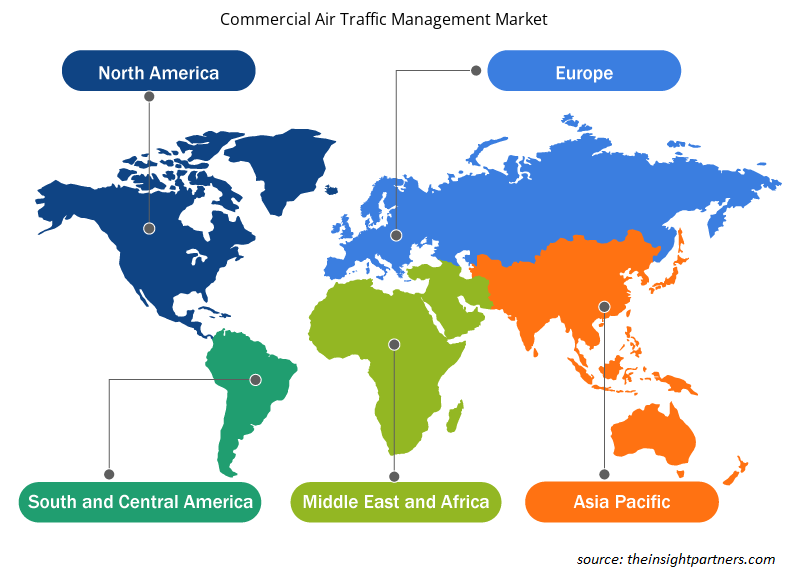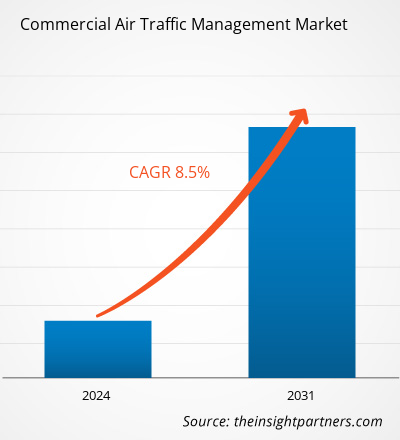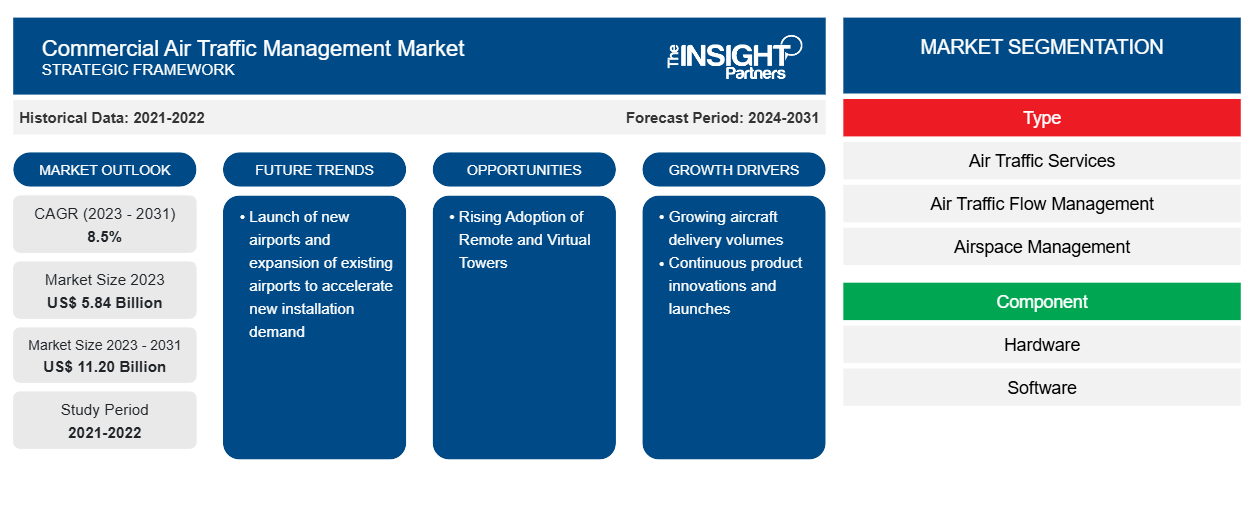Si prevede che la dimensione del mercato della gestione del traffico aereo commerciale raggiungerà 11,20 miliardi di dollari entro il 2031, rispetto ai 5,84 miliardi di dollari del 2023. Si prevede che il mercato registrerà un CAGR dell'8,5% nel periodo 2023-2031. Il lancio di nuovi aeroporti e l'espansione di quelli esistenti per accelerare la domanda di nuove installazioni rimarranno probabilmente una tendenza chiave nel mercato.
Analisi di mercato della gestione del traffico aereo commerciale
Gli acquirenti del mercato della gestione del traffico aereo commerciale includono aeroporti commerciali e le loro autorità che stanno investendo sempre di più nell'approvvigionamento di soluzioni avanzate di gestione del traffico aereo (ATM) per operazioni aeree efficienti e sicure. Attualmente i progetti di costruzione degli aeroporti sono in corso rendendo moderato il potere d'acquisto degli acquirenti. Tuttavia, avvicinandosi alla fine della costruzione degli aeroporti, la domanda di soluzioni ATM aumenterà, aumentando così il potere contrattuale degli acquirenti. Inoltre, la durata di vita dei sistemi ATM commerciali è elevata, portando quindi a un basso potere contrattuale degli acquirenti al momento. Tuttavia, durante il periodo di aggiornamento dei nuovi sistemi ATM negli aeroporti, in particolare quelli esistenti, si prevede che aumenteranno il potere contrattuale degli acquirenti nei prossimi anni.
Panoramica del mercato della gestione del traffico aereo commerciale
I principali stakeholder nell'ecosistema del mercato globale della gestione del traffico aereo commerciale includono produttori di componenti, produttori di hardware, fornitori di software, autorità governative e utenti finali. I produttori di componenti che operano nel mercato globale della gestione del traffico aereo commerciale offrono trasmettitori, antenne, ricevitori, indicatori, batterie, luci, sensori e altre apparecchiature. La fornitura tempestiva di tutti questi componenti è fondamentale per un funzionamento efficiente negli stabilimenti di produzione dei sistemi di gestione del traffico aereo. Se si verifica un impatto operativo su questi fornitori di componenti, si verificherà un ritardo nella produzione del sistema di gestione del traffico aereo , influenzando così direttamente il mercato della gestione del traffico aereo commerciale.
Personalizza questo report in base alle tue esigenze
Riceverai la personalizzazione gratuita di qualsiasi report, comprese parti di questo report, o analisi a livello nazionale, pacchetto dati Excel, oltre a usufruire di grandi offerte e sconti per start-up e università
-
Scopri le principali tendenze di mercato in questo rapporto.Questo campione GRATUITO includerà analisi di dati che spaziano dalle tendenze di mercato alle stime e alle previsioni.
Driver e opportunità del mercato della gestione del traffico aereo commerciale
Innovazioni e lanci continui di prodotti
L'industria aeronautica globale si sta trasformando in termini di prodotti nuovi e innovativi. Gli stakeholder di tutti i settori verticali del settore investono costantemente in R&S per innovare e sviluppare soluzioni solide per semplificare le operazioni industriali. La crescente domanda di sistemi di gestione del traffico aereo ha costretto gli operatori di mercato a investire nello sviluppo di prodotti nuovi e innovativi negli ultimi anni. Di seguito sono menzionati alcuni dei principali sviluppi di prodotto:
- A luglio 2022, EUROCONTROL ha rilasciato un server e tracker di sorveglianza per la gestione del traffico aereo aggiornato (ARTAS). La nuova versione (V 9.0.2) presenta diverse nuove funzionalità provenienti dalla comunità e si segnala che i problemi saranno risolti in essa.
- Nel giugno 2022, Indra Sistemas SA ed Eurocontrol Maastricht Upper Area Control Centre (MUAC) hanno annunciato l'implementazione di una rete di telecomunicazioni aeronautiche (ATN) e di un sistema di sorveglianza automatica dipendente (ADS-C), che consentiranno ai sistemi di controllo del traffico aereo di gestire il traffico aereo in modo accurato.
- A giugno 2022, Thales SA ha annunciato il lancio di HELIXVIEW, uno scanner conforme allo standard C3 che combina la scansione elettronica basata sulla nanotecnologia a raggi X e la ricostruzione di immagini 3D, per garantire maggiore sicurezza negli aeroporti e servizi di viaggio senza interruzioni ai passeggeri.
Tali sviluppi hanno spinto la crescita del mercato della gestione del traffico aereo commerciale a livello mondiale.
Crescente adozione di torri remote e virtuali
Le torri remote e virtuali aiutano a regolare e mantenere le operazioni del traffico aereo da remoto. Vari aeroporti in tutto il mondo hanno adottato queste torri per operazioni aeroportuali più rapide e sicure. A giugno 2022, l'aeroporto di Brindisi ha inaugurato la sua prima torre di controllo gestita da remoto in Italia. La nuova torre digitale remota aiuterà i controllori del traffico aereo a gestire le operazioni di decollo, atterraggio e terra da un modulo torre remoto. Il modulo assisterà anche nella gestione del traffico aereo e migliorerà la sicurezza e l'efficienza operativa dell'aeroporto. A maggio 2022, è stato annunciato che gli aeroporti di Braunschweig-Wolfsburg ed Emden nella Germania settentrionale hanno commissionato a DFS Aviation Services GmbH (DAS) e Frequentis la costruzione di un centro torre remoto nella regione, la cui entrata in funzione è prevista per la metà del 2024. Pertanto, si prevede che la crescente adozione e l'investimento in torri remote e virtuali per una gestione efficiente del traffico aereo stimoleranno la crescita del mercato della gestione del traffico aereo commerciale.
Analisi della segmentazione del rapporto di mercato sulla gestione del traffico aereo commerciale
I segmenti chiave che hanno contribuito alla derivazione dell'analisi di mercato della gestione del traffico aereo commerciale sono tipologia, componente, applicazione e classe di aeroporto.
- In base al tipo, il mercato della gestione del traffico aereo commerciale è segmentato in servizi di traffico aereo, gestione del flusso di traffico aereo e gestione dello spazio aereo . Il segmento della gestione dello spazio aereo ha detenuto una quota di mercato maggiore nel 2023.
- In base al componente, il mercato della gestione del traffico aereo commerciale è suddiviso in hardware e software. Il segmento hardware ha detenuto una quota di mercato maggiore nel 2023. Il segmento hardware è ulteriormente suddiviso in radar, antenne, sistemi di visualizzazione e altri.
- In base all'applicazione, il mercato della gestione del traffico aereo commerciale è segmentato in comunicazione, navigazione, sorveglianza, controllo del traffico e altri. Il segmento della sorveglianza ha detenuto una quota di mercato maggiore nel 2023. Il segmento della navigazione è ulteriormente sottosegmentato in CVOR, DVOR, DME, ILS, DF e NDB. Il segmento della sorveglianza è ulteriormente sottosegmentato in PSR, SSR e MLAT.
- In base alla classe aeroportuale, il mercato della gestione del traffico aereo commerciale è segmentato in Classe I, Classe II, Classe III e Classe IV. Il segmento Classe I ha detenuto una quota di mercato maggiore nel 2023.
Analisi della quota di mercato della gestione del traffico aereo commerciale per area geografica
L'ambito geografico del rapporto di mercato sulla gestione del traffico aereo commerciale è suddiviso principalmente in cinque regioni: Nord America, Europa, Asia Pacifico, Medio Oriente e Africa e Sud America.
Il Nord America ha dominato il mercato nel 2023, seguito da Europa e regioni dell'Asia Pacifica. Inoltre, è probabile che l'Asia Pacifica superi il mercato del Nord America insieme al CAGR più elevato nei prossimi anni. Gli Stati Uniti hanno dominato il mercato della gestione del traffico aereo commerciale nordamericano nel 2023. Ciò è dovuto principalmente al fatto che l'industria aeronautica statunitense è uno dei principali paesi nel settore dell'aviazione globale. Il paese ha il maggior numero di flotte di aeromobili che soddisfano milioni di passeggeri all'anno. Ad esempio, le compagnie aeree statunitensi hanno trasportato oltre 862 milioni di passeggeri nel 2023. L'aumento del traffico passeggeri sta portando all'acquisto di un numero maggiore di flotte di aeromobili tra i vettori statunitensi e generando una maggiore richiesta per le operazioni ATM. Inoltre, l'ammodernamento delle torri ATC esistenti in diversi aeroporti statunitensi e la messa in servizio di nuove torri ATC in diversi aeroporti negli Stati Uniti sta catalizzando la crescita del mercato della gestione del traffico aereo commerciale in tutto il paese. Diversi aeroporti in tutto il paese hanno attraversato diversi processi di espansione che includono anche la costruzione di nuovi terminal, torri ATC e ammodernamenti di altri settori negli aeroporti. Ad esempio, nell'agosto 2022, il Phoenix-Mesa Gateway Airport ha commercializzato una torre ATC per gestire il crescente traffico aereo nell'aeroporto in Arizona. Analogamente, la Federal Aviation Administration (FAA) sta implementando diversi piani aeroportuali per aggiornare i propri sistemi di gestione del traffico aereo per la trasformazione dello spazio aereo statunitense, migliorandone così la sicurezza, l'efficienza e le responsabilità ambientali. Tali fattori hanno spinto la crescita del mercato della gestione del traffico aereo commerciale statunitense nella regione del Nord America.
Approfondimenti regionali sul mercato della gestione del traffico aereo commerciale
Le tendenze regionali e i fattori che influenzano il mercato della gestione del traffico aereo commerciale durante il periodo di previsione sono stati ampiamente spiegati dagli analisti di Insight Partners. Questa sezione discute anche i segmenti e la geografia del mercato della gestione del traffico aereo commerciale in Nord America, Europa, Asia Pacifico, Medio Oriente e Africa e America centrale e meridionale.

- Ottieni i dati specifici regionali per il mercato della gestione del traffico aereo commerciale
Ambito del rapporto di mercato sulla gestione del traffico aereo commerciale
| Attributo del report | Dettagli |
|---|---|
| Dimensioni del mercato nel 2023 | 5,84 miliardi di dollari USA |
| Dimensioni del mercato entro il 2031 | 11,20 miliardi di dollari USA |
| CAGR globale (2023-2031) | 8,5% |
| Dati storici | 2021-2022 |
| Periodo di previsione | 2024-2031 |
| Segmenti coperti |
Per tipo
|
| Regioni e Paesi coperti |
America del Nord
|
| Leader di mercato e profili aziendali chiave |
|
Densità degli attori del mercato: comprendere il suo impatto sulle dinamiche aziendali
Il mercato della gestione del traffico aereo commerciale sta crescendo rapidamente, spinto dalla crescente domanda degli utenti finali dovuta a fattori quali l'evoluzione delle preferenze dei consumatori, i progressi tecnologici e una maggiore consapevolezza dei vantaggi del prodotto. Con l'aumento della domanda, le aziende stanno ampliando le loro offerte, innovando per soddisfare le esigenze dei consumatori e capitalizzando sulle tendenze emergenti, il che alimenta ulteriormente la crescita del mercato.
La densità degli operatori di mercato si riferisce alla distribuzione di aziende o società che operano in un particolare mercato o settore. Indica quanti concorrenti (operatori di mercato) sono presenti in un dato spazio di mercato in relazione alle sue dimensioni o al valore di mercato totale.
Le principali aziende che operano nel mercato della gestione del traffico aereo commerciale sono:
- Talete SA
- Sistemi BAE Plc
- Indra Sistemas SA
- Tecnologie L3Harris Inc.
- Società di tecnologie Raytheon
- Honeywell International Inc
Disclaimer : le aziende elencate sopra non sono classificate secondo un ordine particolare.

- Ottieni una panoramica dei principali attori del mercato della gestione del traffico aereo commerciale
Notizie di mercato e sviluppi recenti sulla gestione del traffico aereo commerciale
Il mercato della gestione del traffico aereo commerciale viene valutato raccogliendo dati qualitativi e quantitativi dopo la ricerca primaria e secondaria, che include importanti pubblicazioni aziendali, dati associativi e database. Di seguito sono elencati alcuni degli sviluppi nel mercato della gestione del traffico aereo commerciale:
- A seguito del contratto firmato nel 2014 con Zambia Airports Corporation Limited (ZACL), Thales sta modernizzando i centri ATC (controllo del traffico aereo) degli aeroporti internazionali di Lusaka e Livingstone in Zambia. (Fonte: Thales, comunicato stampa, ottobre 2023)
- EUROCONTROL MUAC e Indra hanno implementato un innovativo sistema ATN Automatic Dependent Surveillance Contract (ADS-C) per lo scambio automatico di dati con gli aeromobili in volo per aumentare la precisione con cui viene gestito il traffico. Aumenterà la prevedibilità, faciliterà il rilevamento precoce dei conflitti e sarà il primo passo verso le Trajectory Based Operations (TBO). Ottimizzerà inoltre le salite e le discese degli aeromobili, mantenendoli a livelli di volo ottimali per più tempo e riducendo al minimo il consumo di carburante (Fonte: Indra, Comunicato stampa, giugno 2022)
Copertura e risultati del rapporto di mercato sulla gestione del traffico aereo commerciale
Il rapporto "Dimensioni e previsioni del mercato della gestione del traffico aereo commerciale (2021-2031)" fornisce un'analisi dettagliata del mercato che copre le seguenti aree:
- Dimensioni e previsioni del mercato della gestione del traffico aereo commerciale a livello globale, regionale e nazionale per tutti i segmenti di mercato chiave coperti dall'ambito
- Tendenze del mercato della gestione del traffico aereo commerciale e dinamiche di mercato come conducenti, restrizioni e opportunità chiave
- Analisi dettagliata delle cinque forze di Porter
- Analisi di mercato della gestione del traffico aereo commerciale che copre le principali tendenze del mercato, il quadro globale e regionale, i principali attori, le normative e i recenti sviluppi del mercato
- Analisi del panorama industriale e della concorrenza che copre la concentrazione del mercato, l'analisi della mappa di calore, i principali attori e gli sviluppi recenti per il mercato della gestione del traffico aereo commerciale
- Profili aziendali dettagliati
- Analisi storica (2 anni), anno base, previsione (7 anni) con CAGR
- Analisi PEST e SWOT
- Valore/volume delle dimensioni del mercato - Globale, Regionale, Nazionale
- Industria e panorama competitivo
- Set di dati Excel
Report recenti
Rapporti correlati
Testimonianze
Motivo dell'acquisto
- Processo decisionale informato
- Comprensione delle dinamiche di mercato
- Analisi competitiva
- Analisi dei clienti
- Previsioni di mercato
- Mitigazione del rischio
- Pianificazione strategica
- Giustificazione degli investimenti
- Identificazione dei mercati emergenti
- Miglioramento delle strategie di marketing
- Aumento dell'efficienza operativa
- Allineamento alle tendenze normative























 Ottieni un campione gratuito per - Mercato della gestione del traffico aereo commerciale
Ottieni un campione gratuito per - Mercato della gestione del traffico aereo commerciale